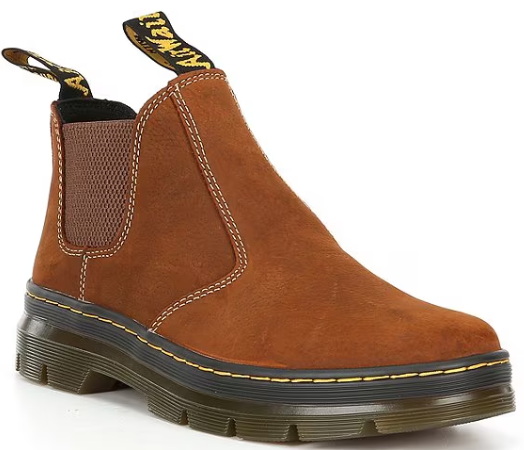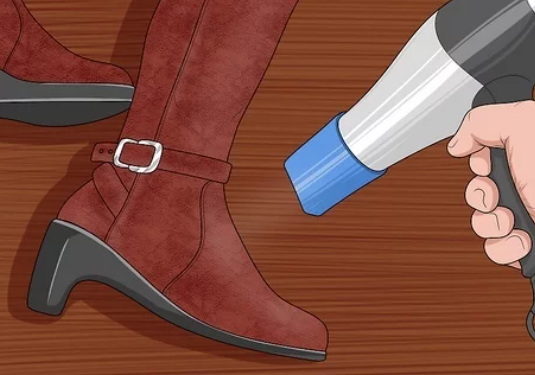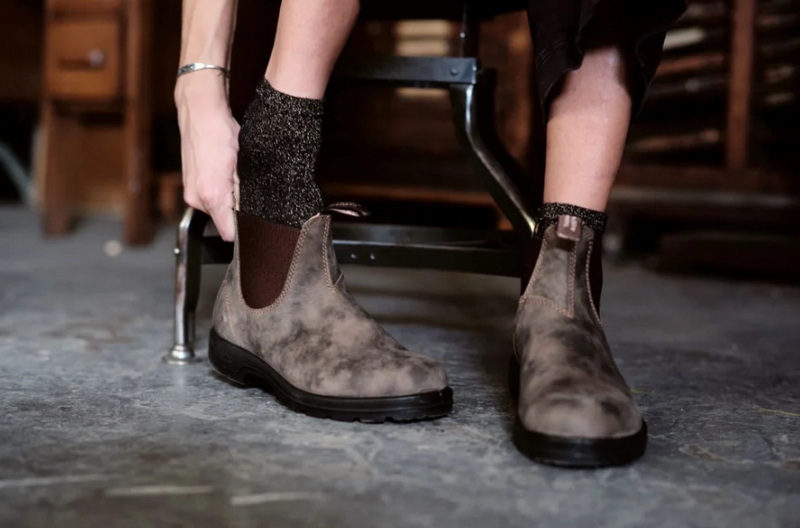Content Menu
● The Nature of Chelsea Boots
>> Leather Properties
>> Elastic Side Panels
● Do Chelsea Boots Stretch?
● Breaking In Your Chelsea Boots
>> 1. Wear Them Around the House
>> 2. Use Thick Socks
>> 3. Gradual Increase in Wear Time
● Methods to Stretch Chelsea Boots
>> 1. Shoe Stretcher
>> 2. Heat and Moisture Method
>> 3. Leather Stretching Spray
>> 4. Rubbing Alcohol Solution
● Proper Care for Stretched Chelsea Boots
● When to Seek Professional Help
● Conclusion
● FAQ
>> 1. How long does it take for Chelsea boots to stretch?
>> 2. Can I stretch Chelsea boots made of suede?
>> 3. Is it possible to over-stretch Chelsea boots?
>> 4. Can Chelsea boots be stretched in length?
>> 5. How often should I condition my stretched Chelsea boots?
● Citations:
Chelsea boots are a timeless and versatile footwear option that has been a staple in many wardrobes for decades. One common question that arises when purchasing these stylish boots is whether they stretch over time. In this comprehensive guide, we'll explore the stretching properties of Chelsea boots, how to break them in, and various methods to ensure a comfortable fit.

The Nature of Chelsea Boots
Chelsea boots are characterized by their elastic side panels and pull-on design. Typically made from leather or suede, these boots are known for their sleek appearance and snug fit. The construction of Chelsea boots plays a significant role in their ability to stretch and conform to the wearer's feet.
Leather Properties
Most Chelsea boots are crafted from leather, which is a natural material known for its elasticity and ability to mold to the shape of the foot over time[1]. This inherent property of leather allows Chelsea boots to stretch and adapt to the wearer's foot shape with regular use.
Elastic Side Panels
The elastic side panels are a defining feature of Chelsea boots. These panels are designed to provide flexibility and ease of putting on and taking off the boots. While the elastic itself doesn't stretch significantly, it does allow for some give, contributing to the overall comfort and fit of the boot[9].
Do Chelsea Boots Stretch?
The short answer is yes, Chelsea boots do stretch, but the extent of stretching depends on various factors:
1. Material: Leather Chelsea boots tend to stretch more than those made from synthetic materials.
2. Quality: Higher-quality leather is more likely to stretch and mold to your foot shape.
3. Wear frequency: Regular wear will accelerate the stretching process.
4. Care and maintenance: Proper care can help maintain the leather's elasticity.
It's important to note that while Chelsea boots will stretch, they should still fit snugly from the start. As one expert puts it, "The elastic and leather of the boots will stretch over time through wear, meaning it is essential to get a good snug fit from the start, ensuring your heel is not slipping out of the boots when you walk."[12]
Breaking In Your Chelsea Boots
Breaking in your Chelsea boots is crucial for achieving optimal comfort and fit. Here are some effective methods to help you break in your new boots:
1. Wear Them Around the House
Start by wearing your new Chelsea boots around the house for short periods. This allows the leather to soften and adapt to the shape of your feet without the risk of discomfort during extended wear[1].
2. Use Thick Socks
Wearing thick socks while breaking in your boots can help stretch the leather more quickly. This method is particularly effective when combined with gentle heat from a hairdryer[6].
3. Gradual Increase in Wear Time
As your boots become more comfortable, gradually increase the duration of wear. This consistent use will help the leather continue to stretch and mold to your feet[1].

Methods to Stretch Chelsea Boots
If your Chelsea boots feel too tight, there are several methods you can try to stretch them:
1. Shoe Stretcher
A shoe stretcher is a device designed to expand the width or length of a boot. It's an effective tool for stretching Chelsea boots, especially when used in conjunction with a leather conditioner[1][11].
2. Heat and Moisture Method
Applying gentle heat from a hairdryer to tight areas of the boot can help soften the leather. Wear thick socks and walk around to allow the heat from your feet to further soften and stretch the leather[4].
3. Leather Stretching Spray
Professional leather stretching sprays are designed to loosen leather material. Apply the spray to tight areas and then wear the boots or use a shoe stretcher for best results[5].
4. Rubbing Alcohol Solution
A mixture of rubbing alcohol and water (1:3 ratio) can be applied to tight areas of the boot. Wear the boots with thick socks until the leather is completely dry[5].
Proper Care for Stretched Chelsea Boots
Once you've successfully stretched your Chelsea boots, proper care is essential to maintain their shape and longevity:
1. Use a leather conditioner regularly to keep the leather supple[10].
2. Store your boots in a cool, dry place away from direct sunlight[7].
3. Use shoe trees or stuff your boots with newspaper when not in use to maintain their shape[6].
4. Clean your boots regularly and apply a protective spray to guard against water and stains[10].
When to Seek Professional Help
If DIY methods don't provide the desired results, consider seeking help from a professional cobbler. They have specialized equipment and expertise to stretch boots without damaging the leather[4].
Conclusion
Chelsea boots do indeed stretch over time, primarily due to the natural properties of leather and the elastic side panels. While they will adapt to your feet with wear, it's crucial to start with a snug but comfortable fit. Breaking in your boots gradually and using appropriate stretching techniques can help achieve the perfect fit. Remember that proper care and maintenance are essential for preserving the shape and longevity of your Chelsea boots.

FAQ
1. How long does it take for Chelsea boots to stretch?
The time it takes for Chelsea boots to stretch can vary depending on the material, frequency of wear, and stretching methods used. Generally, you can expect noticeable stretching within a few days to a few weeks of regular wear[4].
2. Can I stretch Chelsea boots made of suede?
Yes, suede Chelsea boots can be stretched, but it's important to use gentler methods. Avoid excessive heat or moisture, as these can damage the suede. A suede-specific stretching spray and a shoe stretcher are often the safest options[4].
3. Is it possible to over-stretch Chelsea boots?
While it's possible to over-stretch boots, it's relatively rare with Chelsea boots due to their construction. However, using excessive force or heat can potentially damage the leather or elastic panels. It's best to stretch gradually and stop once you achieve a comfortable fit[1].
4. Can Chelsea boots be stretched in length?
Chelsea boots are primarily designed to stretch in width rather than length. While some minimal lengthening may occur with wear, it's generally not significant. If your boots are too short, it's better to consider a different size[4].
5. How often should I condition my stretched Chelsea boots?
The frequency of conditioning depends on how often you wear your boots and the conditions they're exposed to. As a general rule, conditioning every 1-3 months is sufficient for regularly worn boots. However, if your boots are exposed to harsh conditions or frequent wear, you may need to condition them more often[10].
Citations:
[1] https://chelseabootstore.com/how-to-break-in-your-chelsea-boots/
[2] https://www.overlookboots.com/blogs/boots/how-to-stretch-leather-boots
[3] https://www.aquila.com.au/style-guide/how-to-care-for-leather-boots
[4] https://stylewhirl.com/how-to-stretch-chelsea-boots/
[5] https://bakershoe.com/blogs/news/how-to-stretch-and-soften-leather-boots
[6] https://styledbyscience.com/how-to-stretch-leather-boots-at-home/
[7] https://bakershoe.com/blogs/news/the-complete-leather-boot-care-guide
[8] https://stylewhirl.com/how-to-stretch-chelsea-boots-overnight/
[9] https://www.pavers.co.uk/blogs/how-should-chelsea-boots-fit
[10] https://www.harpersbazaar.com/fashion/trends/a4413/how-to-take-care-of-leather-and-suede-boots/
[11] https://www.blundstone.com/how-to-break-in-chelsea-boots
[12] https://www.ahume.co.uk/blog/chelsea-boots-the-ultimate-buyers-guide/

















